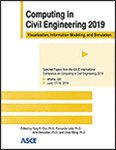ASCE International Conference on Computing in Civil Engineering 2019
Enhance the Simulation of Architecture and Engineering Design Process: A Data-Driven Based Approach
Publication: Computing in Civil Engineering 2019: Visualization, Information Modeling, and Simulation
ABSTRACT
Virtual design team (VDT) is one of the architecture and engineering (A&E) design planning and control methods. Current VDT software is not data-driven like most available methods, and its simulation is based on questionnaires and on designers’ experiences. Managers may end up making decisions using limited information because there is no simple process that allows them to become familiar with all team members’ performances. There is a need to investigate the benefits of a data-driven approach that supports design process simulations by using A&E designers’ performance parameters. This study explored the performance parameters of a designers’ performance statistics, being how early they started tasks. Designers’ outputs for the same tasks can be different when they are working for different clients and managers. Designers’ performances described and extracted from data acquired from past projects allow for the customization of design simulations by changing their inputs and parameters according to specific project characteristics. The comparison between original simulations and simulations with features extracted from an existing A&E database revealed that a process simulation that is data-driven can improve the accuracy of the simulation to help better plan and control the design process.
Get full access to this article
View all available purchase options and get full access to this chapter.
REFERENCES
Aalst, W. M. P. Van, Der, & Nakatumba-nabende, J. (2010). Business Process Simulation : How to Get it Right ? Business Process Simulation : How to get it right ?, (January).
Aqel, D., & Vadera, S. (2013). A Framework for Employee Appraisals Based on Inductive Logic Programming and Data Mining Methods BT - Natural Language Processing and Information Systems. In E. Métais, F. Meziane, M. Saraee, V. Sugumaran, & S. Vadera (Eds.) (pp. 404–407). Berlin, Heidelberg: Springer Berlin Heidelberg.
Du, J., & El-Gafy, M. (2012). Virtual Organizational Imitation for Construction Enterprises: Agent-Based Simulation Framework for Exploring Human and Organizational Implications in Construction Management. Journal of Computing in Civil Engineering, 26(3), 282–297.
Galbraith, J. R. (1974). Organization Design : An Information Processing View, 4(3), 28–36.
Jin, Y., & Levitt, R. (1996). The Virtual Design Team : A Computational Model of Project Organizations. Computational & Mathematical Organization Theory, 2(3), 171–196.
Lewis, K., Gonzalez, M., & Kaufman, J. (2012). Social selection and peer influence in an online social network. Proceedings of the National Academy of Sciences, 109(1), 68–72.
Liu, Y., Wang, J., Yang, Y., & Sun, J. (2008). A semi-automatic approach for workflow staff assignment. Computers in Industry, 59(5), 463–476.
Marcoulides, G. A., & Heck, R. H. (1993). Organizational Culture and Performance: Proposing and Testing a Model. Organization Science, 4(2), 209–225.
Mendes, A. de, S., Sousa, R. T. de, Martins, V. A., & Deus, F. E. G. de. (2014). Application of data mining techniques in the characterization of internal personnel turnover. In 2014 9th Iberian Conference on Information Systems and Technologies (CISTI) (pp. 1–6).
Palshikar, G. K., Sahu, K., & Srivastava, R. (2015). After You, Who? Data Mining for Predicting Replacements. In Proceedings of the Third International Conference on Mining Intelligence and Knowledge Exploration - Volume 9468 (pp. 543–552). Berlin, Heidelberg: Springer-Verlag.
Rummler, G. A., & Brache, A. P. (1988). The three levels of quality. Quality Progress.
Tversky, A., Kahneman, D., Series, N., & Sep, N. (1974). Judgment under Uncertainty : Heuristics and Biases, 185(4157), 1124–1131.
Yahyaei, M. Y. S. Y. J. (2009). PMT: Modeling Enterprise Operations and Organizations Majid. Proceedings of the International Design Engineering Technical Conferences & Computers and Information in Engineering Conference IDETC/CIE 2009.
Zhang, L., Wen, M., & Ashuri, B. (2018). BIM Log Mining: Measuring Design Productivity. Journal of Computing in Civil Engineering, 32(1), 04017071.
Information & Authors
Information
Published In
Computing in Civil Engineering 2019: Visualization, Information Modeling, and Simulation
Pages: 626 - 634
Editors: Yong K. Cho, Ph.D., Georgia Institute of Technology, Fernanda Leite, Ph.D., University of Texas at Austin, Amir Behzadan, Ph.D., Texas A&M University, and Chao Wang, Ph.D., Louisiana State University
ISBN (Online): 978-0-7844-8242-1
Copyright
© 2019 American Society of Civil Engineers.
History
Published online: Jun 13, 2019
Authors
Metrics & Citations
Metrics
Citations
Download citation
If you have the appropriate software installed, you can download article citation data to the citation manager of your choice. Simply select your manager software from the list below and click Download.
